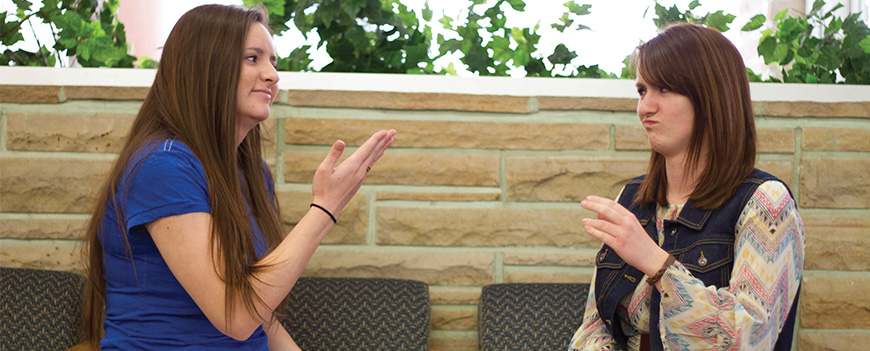Sign language program gains popularity
The growth of the deaf education and American Sign Language programs is a trend across the nation, and the deaf education program at Utah State University is no exception.
College student enrollment in all foreign language classes in the U.S. has decreased in recent years, besides ASL courses, according to a recently published study by the Modern Language Association.
“The new minors have been huge,” said Michelle Wilson, adviser for the communicative disorders and deaf education department. “Because it’s a language minor, it adds other options for students.”
The number of students graduating from USU with the two minors in ASL and teaching for ASL is constantly increasing, said Freeman King, director of the deaf education program.
“American Sign Language itself is the third most popular world language that is taken in American universities,” King said. “I think that people, once they find out about the language, are attracted by it being a visual language … and also, there’s been more publicity about the deaf culture, the deaf community through movies, through television series, the media itself.”
ASL classes have more recently been capped at 25 students each, though this is still too many, King said. The department hopes to hire a new faculty member in the next year to help take on the increase of students wanting to take ASL courses, he said.
“Our program is to prepare teachers on the undergrad level,” said Curt Radford, an ASL lecturer in the deaf education program. “We prepare teachers to teach. Some of our students, they would rather go on with something else, and interpreting is one of them.”
Just like all other world languages, when students choose to study ASL in college, they are not always sure what they want to do with it but take it because they are interested in the language, King said.
“People see (sign language) and they want to learn it,” Radford said. “It opens up a conversation.”
Once students become comfortable a language, they then want to start meeting and interacting with the people who speak the language and learn their culture, he said.
“There is a direct parallel among languages, whether they be spoken or whether they be signed,” King said. “American Sign Language is exactly like any other language except it’s not based on auditory, on listening. It’s a visual language, but it has all of the components of any other language.”
Though some think ASL is just English with hand signals, it has it’s own structure and is not connected to English or a visual representation of English.
King said language is a learning process for everyone. There is a difference between basic communication skills and being able to communicate deeply, and though no students are expected to be fluent, even at graduation, they are headed in the right direction.
Interest in learning ASL began in high school for both Sarah Rocha, a sophomore majoring in physical therapy, and Jordyn Jensen, a freshman majoring in early childhood education. Both are currently in the beginning ASL course, but Jensen wants to minor in deaf education.
“It’s kind of mind-boggling,” Rocha said. “I’m speaking to you with my hands and you’re understanding me…And the culture, the way they interact with each other, it’s really interesting.”
Deaf culture is very different in the sense that the people are so open about everything and are very involved in the world around them, Jensen said.
“It’s so great to discover what is different and what’s the same just because of one small difference,” Jensen said.
Sign language is not only limited to hands, but involves facial expressions too. In order to communicate signers have to be animated.
“It’s a beautiful language,” Jensen said. “To watch two people sign to each other and because they’re going so fast, because they’re both fluent, it’s so amazing to watch.”
Silent Weekend, an annual event put on nationwide, will be celebrated April 17-18 by the USU ASL Club and can be registered for at desa.usu.edu/237.
— mandy.m.morgan@aggiemail.usu.edu

